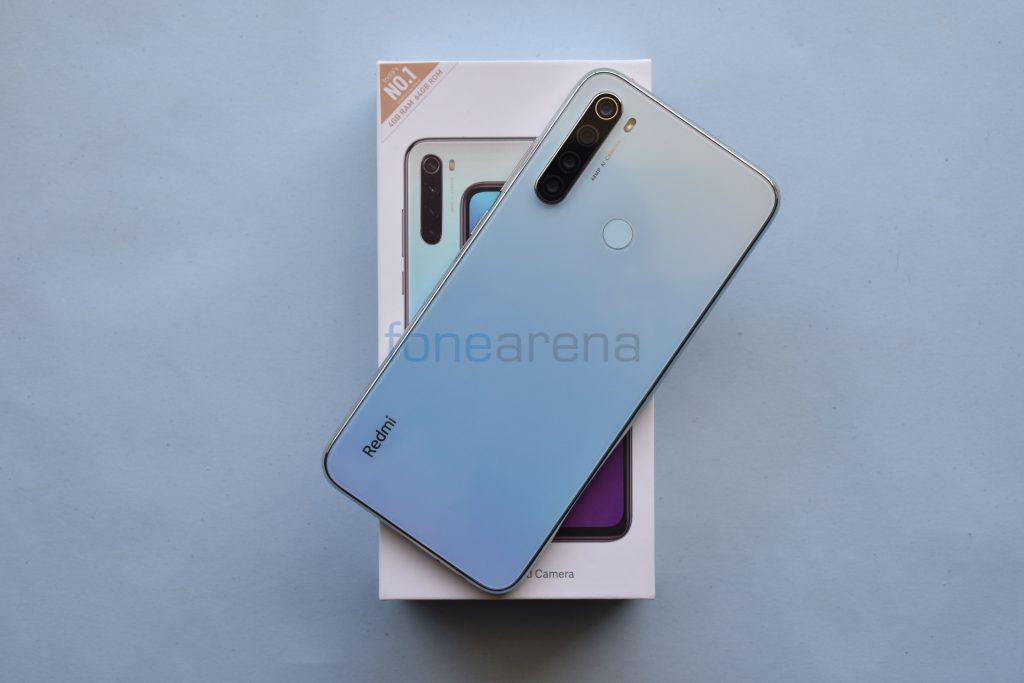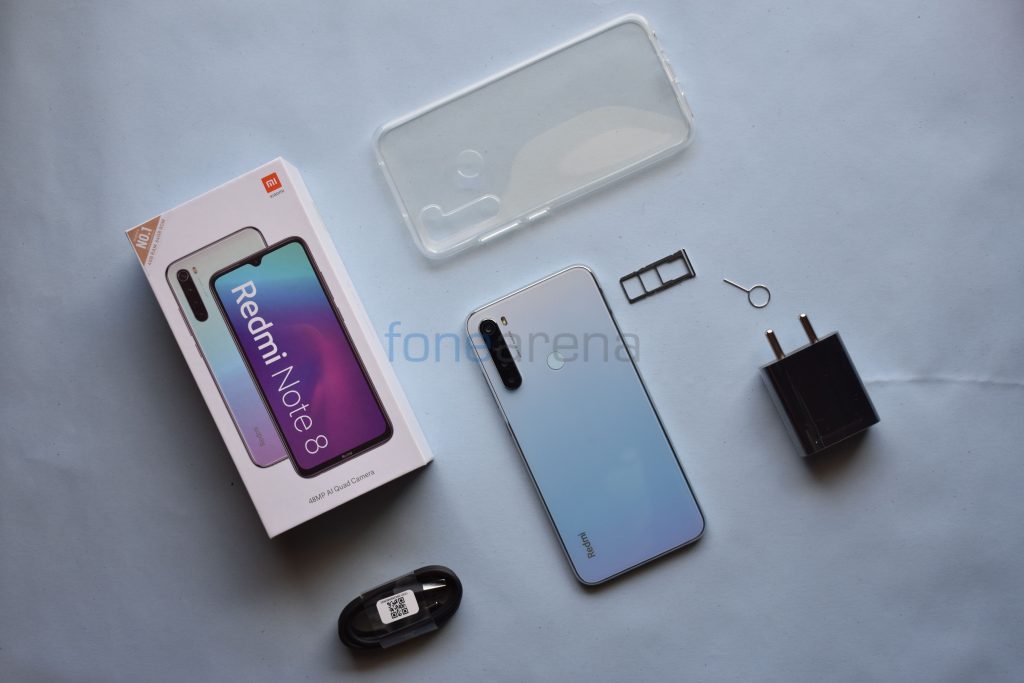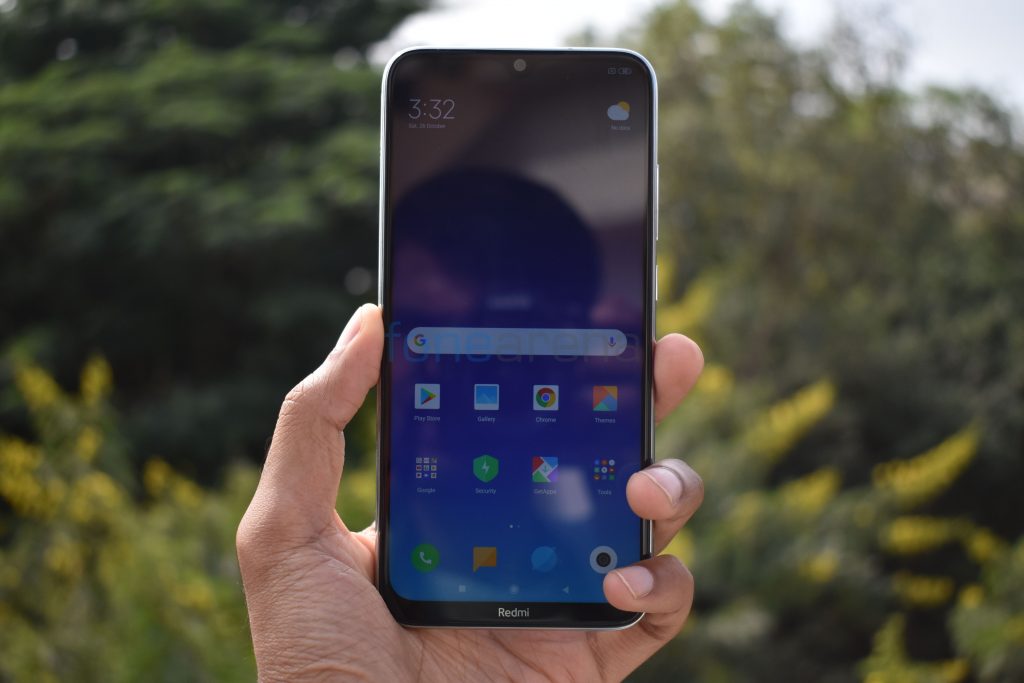

Redmi launched the Redmi Note 8 series in the country back in October, the Pro variant has been in the headlines but the vanilla Redmi Note 8 also offers quad-camera setup. It’s been almost 6 months since the launch and the device has received multiple software updates including MIUI 11. We have used the device for a few months now and here is our long term review of Redmi Note 8.
Unboxing and Box Contents


- Xiaomi Redmi Note 8 in Moonlight White color
- 18W charger (9V-2A)
- USB Type-C cable
- SIM ejector tool
- Clear protective case
- User guide
Design


Redmi Note 8 brings nothing (other than the new paint-jobs) new to the table when it comes to design. The company has retained the same glass sandwich design from the Redmi Note 7 series and Redmi Note 8 features an all-new Aura Fluid design.
Redmi Note 8 features a modern bezel-less dot-notch display with a 19.5:9 aspect ratio protected under Corning Gorilla Glass 5 protection. Even though the phone has a large screen, it is compact to hold and can be managed with a single hand if you have big palms. Similar to other smartphones in this price range, there is a bezel below the display resulting in about 90% screen to body ratio.
Similar to all other devices with dot-notch, there is an earpiece on the top edge above the display. The dot-notch houses a 13-megapixel front camera with f/2.0 aperture. The usual set of the proximity sensor and ambient light sensors are present on the right side of the earpiece but these are hardly visible, the white notification LED can be found on the top left.
There is a small bezel below the display with the Redmi branding. The phone has a plastic finish on the sides, so there are no issues for the signal reception.
Talking about the placement, the right side of the mobile has volume and power buttons, with tactile feedback.
MicroSD and dual SIM slot can be found on the left, there is a dedicated Micro SD slot, so you can use 2 Sim cards and a Micro SD card (up to 256 GB) simultaneously. The top of the device houses an IR Blaster and a secondary noise cancellation microphone, the 3.5 mm headphone jack, primary microphone, Type-C charging port, and speaker grill can be found at the bottom.
Redmi Note 8 features a glass back with Corning Gorilla Glass 5 protection similar to Redmi Note 7 series devices but comes with all-new Aura Fluid design. Quad-cameras are arranged in a vertical array, the LED flash can be found along-side the camera array. The fingerprint sensor can also be found on the back but it’s a little smaller than the Redmi Note 7 series devices.
The phone has P2i nano-coating making it splash-proof and it can also withstand light rain, but can’t be immersed in water since it lacks IP rating. Redmi Note 8 has a thickness of 8.35 mm thick and weighs just 188 grams. The width of the phone is 75.30 mm and the height is 158.3 mm.
There is a thick camera bump at the back, that makes phone wobble when placed on a flat surface. Redmi has bundled a good quality TPU case with the phone, that protects the phone well and hides the camera bump as well.
Even though Redmi Note 8 features with Corning Gorilla Glass 5 protection, the phone gets scratched easily, so it is advised to put a case on the phone. The rear glass attracts fingerprint easily and it is slippery to hold. The camera lens doesn’t get scratched easily, seems like it has some kind of scratch-resistant glass.
Overall, the phone is well-built, comes with P2i coating Corning Gorilla Glass 5 protection, has even weight distribution and buttons offer decent tactile feedback.
Display
Redmi Note 8 has a large 6.3-inch Full HD+ IPS LCD screen with a pixel resolution of 2340 × 1080 pixels and a pixel density of about 403 PPI. It features a dot-notch display 19.5:9 aspect ratio 2.5D curved glass screen with rounded corners.
The display is bright, thanks to 500 nits brightness and 1500:1 contrast ratio and the colors are vibrant since it has 84% of NTSC color gamut. The TÜV Rheinland certified display also has Corning Gorilla Glass 5 protection but the display picks up minor scratches, so it’s better to put a screen guard on it.
Under the display settings, there are different options to adjust colors and contrast based on your preference. MIUI offers a reading mode that lets you reduce the blue light emission so it doesn’t cause eye strain when you use your device at night. An option to hide the dot-notch can also be found in display settings.
To sum it up, the display is bright and vibrant so there shouldn’t be any issue while using the device outdoor. The color reproduction on the device is not very accurate but you can’t really complain about it in this price range.
Camera
Redmi Note 8 packs 5 cameras in total, 4 at the back and 1 at the front, the quad cameras at the back are arranged in a vertical array. An LED flash can be found next to the camera array.
- 8-megapixel 120° ultra-wide-angle Omnivision 8856 sensor with 1.12μm pixel size and f/2.2 aperture
- 48-megapixel primary Samsung GM1 with 0.8μm pixel size and f/1.79 aperture
- 2-megapixel depth Omnivision 02a10 sensor with 1.75μm pixel size and f/2.4 aperture
- 2-megapixel macro Omnivision 02a10 sensor with 1.75μm pixel size and f/2.4 aperture
- 13-megapixel front camera featuring Omnivision 13855 sensor with 1.12μm and f/2.0 aperture
The camera UI is familiar with other Xiaomi smartphones running MIUI 11 with flash, HDR, AI, Macro mode, color modes (Normal, Vivid, Film, Amour, Latte, Sun, Cookie, Calm, Soda, Gourmet, Glow, Berries, B&W and Fade) on the top. Pressing the menu option shows camera frame, timer, tilt-shift, straighten and Google lens. There is a front camera toggle on the bottom along with option to select modes such as Slow motion, Short Video, Video, Photo, 48MP, Portrait, Night, Panorama and Pro mode to adjust white balance, focus, shutter speed (1/1000s to 32 seconds), ISO (100 to 3200) and option to select main, ultra-wide and macro lens. Beautify option for the front camera lets you adjust several features, in addition to smoothness.
Xiaomi has enabled Cam2API by default on a Redmi device, and so users can side load ported Google Camera apks for advanced editing including RAW capture.
Coming to the image quality, daylight shots came out great with good dynamic range, HDR shots looked more details. Dual camera portrait shots were good and the edge detection was good as well. Low-light shots are just fine, and there is a night mode making the images brighter offering more details. Images with flash are good and the flash is not overpowering. By default, it shoots in 12MP resolution and if you want to shoot in 48MP resolution, there is a dedicated 48MP mode but the 48 MP resolution images are as big as 15 MB in size.
The 8 MP ultra-wide camera adds a new wider perspective but the images shot with the 8 MP lens are just average and there is a noticeable color shift in the images, the default camera app also offers an option to fix distortion captured with the ultra-wide lens. The 2 MP macro lens allows you to get closer to the objects and does a good job in daylight.
Daylight front camera shots are decent, but low-light shots are just average. Most of the time we found images captured in AI mode more pleasing to eyes. Portrait for the front camera looks artificial since it uses a software-based blur. Check out some camera samples (Click the image to view the full resolution sample).
It can record 4K 30fps, 1080p 30 fps, 1080p 60 fps, 720p 30fps videos and can also record 1080p 120 fps, 720p 120fps, and 720p 240fps slow-motion videos. It can also record 1080p and 720p videos at 30fps using wide-angle-lens and 720p video at 30fps using Macro lens. Check out video samples below.
Software, UI, and Apps
Redmi Note 8 runs on Android 9.0 (Pie) with January Android security patch as of now, the company has already rolled out MIUI 11 update that brought tons of new features such as New Minimalistic Design, Quick Replies, New Dynamic Sound Effects, Redesigned Settings Menu, Mi Share, Floating Calculator, Updated Mi File Manager, Digital Wellbeing and more to the devices.
Out of 4 GB RAM, around 3.7 GB RAM is usable, and about 2.1 GB of RAM is free when default apps are running in the background. Out of 64 GB, you get about 50 GB of free storage.
Apart from the usual set of utility apps, Google apps and Xiaomi’s own set of apps, it comes pre-loaded with Amazon Shopping, Facebook, Netflix, Dailyhunt, Gaana, Opera Mini and more apps. It also asks for additional app installation during setup, which you can skip. You can easily uninstall these apps, but these come up when you reset the phone.
Xiaomi is infamous for showing ads on its phones with MIUI, which the company says is done in order to support the development cost of its own apps. If you don’t want to see ads, you have to disable recommendations while setting the phone up, promoted apps and in Xiaomi’s own apps such as Music, Mi Video, File Manager, Mi Drop, App Vault, Cleaner, and others. You can also uninstall these apps by following the procedure here without rooting the phone.
Fingerprint sensor and Face unlock
The phone has a fingerprint sensor on the back, we found it fast, accurate and reliable during our time with the device. The phone can be unlocked by even a short tap on the fingerprint sensor. Users can add up to 5 fingerprints which can also be used for app lock and payments in apps. The phone also has face unlock which is slower if you compare it with the fingerprint unlock method, it is also not as secure as fingerprint since it can be unlocked with a photo. It also doesn’t work if you use sunglasses or hats.
Music Player, FM Radio and Multimedia
The Mi Music Player is the default music player which also has online streaming integration from Hungama. It also has FM Radio with recording. Audio through the speaker is loud and clear for the most part, thanks to 1217 linear speakers. Since the speaker is placed on the bottom, audio doesn’t get muffled when the phone is on a flat surface.
Xiaomi has also introduced self-cleaning speaker technology that purges obstructions and dust from the speaker cavity with the help of low-frequency sound waves of 800 Hz. MIUI also offers headphones and audio effects which also has an equalizer option. DRM Info app shows it has Widevine L1 support, but we couldn’t play HD content on Netflix or Amazon Prime Video.
Dual SIM and Connectivity
It has the usual set of connectivity features such as Wi-Fi 802.11 ac (2.4 + 5GHz), Bluetooth 5, GPS + GLONASS. Similar to Snapdragon 660, Snapdragon 665 also has an integrated Snapdragon X12 LTE modem. Redmi Note 8 has 4G connectivity and also has Voice-over-LTE (VoLTE), Voice-over-WiFi (VoWiFi) support for Reliance Jio, Airtel and supports Dual 4G VoLTE that lets you use 4G on both the SIMs.
Redmi Note 8 has USB OTG support that lets you connect USB drives but it lacks Wi-Fi passthrough that lets users use Wi-Fi and Wi-Fi hotspot at the same time. The dialer and messaging UI are similar to other Xiaomi smartphones running MIUI 11. Since this is a dual SIM phone, you get the option to select either SIMs when calling or sending a text message. We did not face any call drops and the earpiece volume is good as well.
Performance and Benchmarks
Coming to the benchmark, the Redmi Note 8 is powered by an Octa-core Qualcomm Snapdragon 665 64-bit 11nm mobile platform based on FinFET technology with Adreno 610 GPU. As it can see from the synthetic benchmark scores below, it is clear that the Snapdragon 665 SoC is better than the Snapdragon 660 that powers Redmi Note 7 and Redmi Note 7S.
We did not face any issues in the graphic-intensive games, but we did encounter occasional frame drops in heavy games, PUBG works in low graphics by default. It gets a bit warm on intensive gaming and 4G data use, but it doesn’t too hot to handle. The Game Booster offers several customization options such as Performance mode that offers bandwidth priority, optimized touch controls and enhanced audio. Check out some synthetic benchmark scores below.
We would like to mention that benchmark scores don’t always reflect real-world performance, and you shouldn’t be making a choice purely on the basis of benchmarks. Qualcomm Snapdragon 665 performs well in day-to-day tasks, especially at this price point, it looks like the most appropriate choice.
Battery life
Redmi Note 8 a 4000mAh (typical)/3900mAh (minimum) non-removable battery under the hood. During our testing, the device lasted for a day easily with heavy usage and two days with moderate usage. The phone also has support for Quick Charge, it takes about 1 hour 43 minutes to charge it from 0 to 100%, 1 hour from 0 to 75% and 42 minutes from 0 to 50% with the bundled 18W charger.
Conclusion
Redmi Note 8 continues the Redmi Note legacy but who is Redmi Note 8 for? If you’re in the market looking for a smartphone with glass-sandwich design, versatile camera setup, good day-to-day performance, and battery life for about Rs. 10k, then Redmi Note 8 is the smartphone to go for. Without any doubt, Redmi Note 8 is a reliable and complete package available in this price segment, but Xiaomi’s own Redmi Note 7 Pro is its biggest competitor which offers much better gaming performance at a slightly lower price.
There are other offerings such as realme 5s (review) and moto one macro (review) but Redmi Note 8 offers more features compared to both of these. realme 5s features dated micro-USB port and has only HD+ display while moto one macro lacks the ultra-wide-angle lens and it also has HD+ display.
Availability
Redmi Note 8 comes in Moonlight White, Space Black, Cosmic Purple and Neptune Blue colors and is available on mi.com and Amazon. Redmi Note 8 is priced at Rs. 10,499 (after the recent price hike) for the 4GB RAM with 64GB storage and Rs. 12,999 for the 6GB RAM with 128GB storage version.
Pros
- Large ‘Dot Notch’ screen
- Glass sandwich design
- Smooth performance
- Good battery life with 18W fast charger in the box
- USB Type-C
- Dedicated SD Card Slot
- Versatile camera setup that offers a wide-angle and macro lens
- P2i coated splash-resistant body
Cons
- Bloatware and ads in UI
- Glass back is prone to fingerprints
- Huge camera bump





